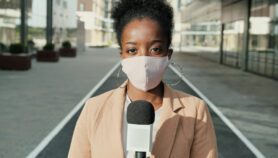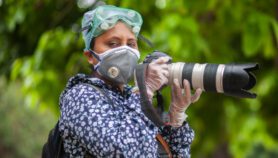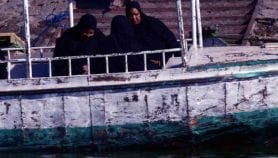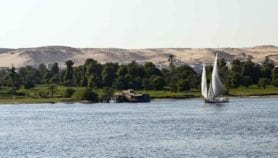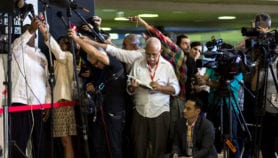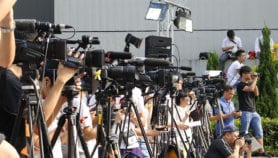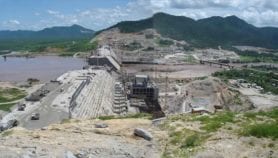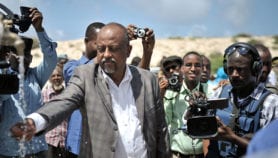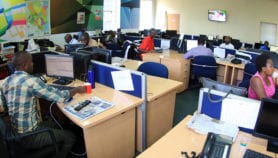By: Rehana Dada
Send to a friend
The details you provide on this page will not be used to send unsolicited email, and will not be sold to a 3rd party. See privacy policy.
Television is a challenging format for science news. Rehana Dada gives some tips for success.
If you’ve set your eye on producing science news for television, then be ready for an information-packing challenge. Not only will you have to condense months, or more likely years, of research into two to three minutes of airtime, but you must also hype-up your story in a way guaranteed to make most scientists cringe. The reward is that you reach hundreds of thousands, or even millions, of viewers — well worth your creative input.
Television is first and foremost about entertainment, and news is about quick, pacey information. When people sit down in front of the television at the end of the day, they aren’t looking to be lectured at. So when you’re planning a news story for television, bear in mind its entertainment value. But don’t let that deter you — it’s always possible to sneak real information in amongst the light stuff.
Which story?
News is about hard fact, controversy, innovation and occasionally entertainment, but there are no ‘right’ or ‘wrong’ science stories for television news. With the right spin, some interesting or animated interviewees, and a good script and footage, you can turn the most lacklustre story into something enjoyable. Try to find stories that are fresh and challenge conventional ways of thinking.
A good grounding
Once you’ve identified a potential news story and received approval for production, research the story thoroughly. Even if you are relying on your interviewees to provide all the information, it is best to chat to them on the phone before you go on shoot to get a sense of the shots you will need and questions you want to ask on-camera. Scan the Internet and books for background information, and definitely talk to people you know in the field for a deeper understanding.
Once you have a fairly good knowledge base, set up on-camera interviews with the relevant people. For a news story you don’t need more than two interviews, but you can probably stretch to three if the story is controversial or needs additional perspectives.
Draft a script to guide your shoot. You may discard this initial script during the edit, but on shoot it is invaluable to keep you on track amid time pressures and information overload. A draft script also helps you select and focus on key aspects of the story.
Good planning allows you to be more relaxed on shoot, and consequently a lot more creative. Before you leave your desk you should have some idea of what shots you need.
When you submit your story, the news station will require information for credits and titling. This includes names for crew members and interviewees and any other relevant information, such as interviewee titles or affiliations. Some stations may require subtitles for broadcast in different languages. You need to provide a timecode for interviewee titles and subtitles. Different stations have different requirements, so be sure to fill in their forms or ask what they need.
Your storyline
For television news, your storyline must be quite simple to fit it into a three-minute slot. You might spend the first 30 seconds introducing the subject, the next minute discussing the new research, the minute following dedicated to controversy or a particular aspect of the research, and the last 30 seconds in conclusion.
The conclusion can be either commentary or a section from interview, but try to avoid using a person for the last picture. Even if you have a longer slot, it’s a good idea to keep to roughly the same structure.
Good interview technique
The camera is an incredibly intimidating piece of equipment, especially because your interviewees know hundreds of thousands of people may watch what they say. Many people overcome their nervousness and deliver sensible, informative answers, but you may need to put some interviewees at ease. One useful technique is to roll camera while you’re still chatting comfortably and gently lead into the questions you want on tape.
If you have a controversial subject, make sure your interviewee knows that the camera is rolling, but keep up your chatty demeanour and tone to help them relax. Even if you are attacking your interviewee on air, make sure your relationship is amicable. If you’re asking the questions, try to get someone else to do the camerawork.
In a three-minute news story there’s little time to unpick complex scientific debates. But if a discovery could lead to some significant rethinking, it’s important to interview an informed commentator about the implications of the work. In this case you will need to make some hard decisions about how to allocate air-time (see Reporting on controversies in science).
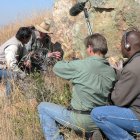
The best locations for shooting are those that illustrate the research
Rehana Dada
Perfect shots
As soon as you’re on location, scout around to find the best spots for interviews, bearing in mind sound — you don’t want to interview someone alongside a noisy highway. Ask your interviewee to point out sites of interest or shots that will support what they are saying.
Think ‘show and tell’: shoot with the aim of visually demonstrating the research. Play with different angles, ensuring straight shots for the interviews, and get close to your subject. Use action shots as much as possible and get your interviewees to demonstrate their work as they talk about it.
Television is a visual medium. You are conveying information through pictures which must tell the story. If you have the luxury of time and your interviewee is willing, it’s worth choosing a location that is related to the story, if not the actual site of relevance.
For example, if new evidence for life is found in 3,500 million-year-old pillow lava, you can hardly make a quick trip to the top of the relevant mountain, so at least try to shoot at similar geological formations nearby. Chemistry stories can be illustrated with bubbling tubes of liquid. If your story is about a wetlands inventory, shoot your interviewees wading knee-deep in mud amongst the bullrushes.
Whatever you do, don’t worry about it looking trite: if it looks cool and is factually correct, use it.
Interest and energy
If time constraints force you to interview someone at their desk, it’s always worth setting up the shot to include something visually interesting — whether flowers or a collection of fossils — without complicating the picture too much. But be sensitive to your subject. You don’t want your viewers admiring a stuffed eagle while your interviewee talks about plasma physics.
A lot depends on your characters. If you have strong, mildly zany or energetic interviewees, then rely on them as much as possible to carry the story.
One of the best ways to slip in complex information is to disguise it with fun or the ‘wow’ factor. Use light jokes and gently make fun of your interviewees. Don’t be afraid to get them to do weird things, such as imitating the movements of the fossil they’ve just discovered.
Don’t forget to record buzz tracks — the sound of the location when no-one is talking. You will need this in edit.
If you have extra time on shoot, it’s definitely worth filming more footage than you think you’ll need to avoid being short of usable visuals. For every five minutes you shoot, you should end up with one minute of usable footage, a 1:5 ratio. So don’t be shy, remember tape is cheap.
Putting it together
Your edit is likely to be the most rewarding and enjoyable part of the process. This is where you bring concepts together to produce your story. But be warned: editing is more time-consuming that you might expect. A good edit can take an hour per minute of completed story, sometimes even longer. At this point you will write your final script and construct the story around interviews.
Pay close attention to sound. The ear is unforgiving, so it can be irritating not to hear the wind when you’re watching scenes of a hurricane, for example. Make sure you select sections of interview that are easily heard and not muffled by other sounds.
It can be tricky to balance the natural sound of the location with the interviews. Work with a sound engineer for your final mix, at least until you learn the skills you need.
Video editing is a matter of compiling shots to tell the story in a way that pleases the eye. There are some general rules that can help and initially you may want to refer to manuals or guidelines. Over time you will find you develop your own style and preferences. A good tip is to always keep your strongest shots for the beginning and end.
For news, keep your edit simple. Use straight cuts throughout, avoid dissolves and don’t even consider page-flips or other such effects. Soft cuts are sometimes necessary for smoothing-out shaky footage, but it’s better to avoid them if possible.
Keep your editing sharp and pacey. Use a number of short shots lasting three to four seconds instead of single long pans or tilts. Make sure you have a good proportion of close-up shots. If you need to make technical corrections, such as colour corrections, rely on a professional editor.
You may have to record commentary for the story. Be sure to check whether the station wants to use your voice or that of another reporter.
The final mix
The final mix is where you smooth out and complete your soundtrack — add natural sound if necessary or effects if they add to the story.
You should have two sound tracks, one that is a complete mix including commentary, and the other a mix that includes natural sound and interviews, but no commentary. This second track will be used if different language stations use your story with their own commentary.
Remember to check with the station what their requirements are; for example they might want two seconds of sound with no picture at the start and end, or one second of picture with no sound to mix to. They all have different ways of working, so check each time.
Have fun with it
It’s challenging and demanding to produce science news for television, especially if you are working to tight deadlines. But it’s also enormous fun to find interesting and imaginative ways to introduce new concepts. So enjoy yourself and let your entertainment brain cells run the show.
Rehana Dada is a science and environment broadcast journalist based in South Africa.



